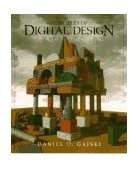Principles of Digtal Design
Editorial Review From Book News, Inc.

Provides an understanding of design’s fundamental principles, without requiring students to memorize a lot of technological details. Chapters 1 through 7 emphasize the traditional combinatorial and sequential design covered in most computer science and computer engineering curricula. Material on register-transfer design of general-purpose and application-specific processors–generally covered in a second course in digital design or in an introductory course in computer architecture–is also presented.
This text is designed to facilitate an understanding of the fundamental principles of design without requiring readers to memorize an excess of confusing technological details. It integrates fundamentals with state-of-the-art techniques in computer design to demonstrate the complete design process, from specification to manufacturing. The book progresses through the design process, ranging in complexity from logic and sequential levels to the levels of RISC processors and complete ASICs. It introduces a generic component library that includes practical design constraints in order to explain concepts and implement worked-out examples. The work takes a contemporary approach to logic and sequential design, emphasizing a coherent design process instead of manual design techniques. An ASIC design process is introduced based on the sequential and behavioural synthesis used in modern CAD tools.
Annotation Copyright © Book News, Inc., Portland, OR
